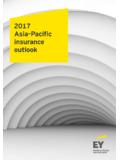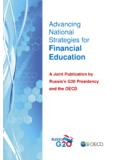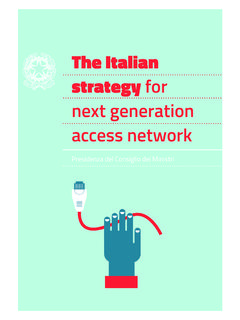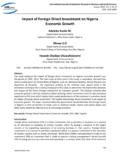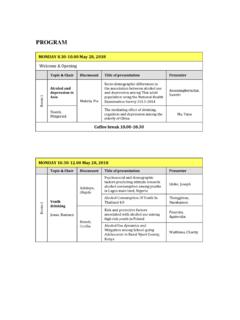Transcription of Mobile Applications for ARD v8
1 Mobile Applications for Agriculture and Rural development Christine Zhenwei Qiang, Siou Chew Kuek*, Andrew Dymond and Steve Esselaar ICT Sector Unit World Bank May 2012 This report is the product of the staff and consultants of the World Bank. The findings, interpretations, and conclusions do not necessarily reflect the views of the Executive Directors of the World Bank or the governments they represent. The World Bank does not guarantee the accuracy of the data included in this work. * Corresponding author: 1818 H Street NW, MSN MC6-616, Washington DC 20433, USA. Contents Foreword .. i ii About the Authors .. iii Abbreviations .. v Executive Summary .. vi 1. Introduction .. 1 What Are Mobile Applications ? .. 1 This Report s Scope, Audience, and Focus .. 5 2. Methodology and Case 7 Typology .. 7 Case Studies .. 8 3. development Impact .. 14 Quantitative Impact .. 17 Qualitative Impact .. 25 4. Mobile Ecosystems .. 26 Key Players.
2 27 30 Highly Local Content and Services .. 33 5. Business Models .. 35 36 Willingness to Pay .. 38 39 Typical revenue streams .. 39 Alternative revenue streams .. 42 Pricing Models .. 43 Nonchargeable model .. 44 Transactional model .. 44 Embedded services model .. 45 Freemium model .. 45 Costs .. 46 49 Different funding issues for commercial and noncommercial Mobile Applications .. 51 Financing forms, types, and cycles .. 52 Possible financing solutions .. 53 6. Conclusion .. 58 Annex A: Typology of Agricultural and Rural development .. 61 Annex B: Information Sheet Used for Desk Research on Mobile Applications .. 63 Annex C: Types of Mobile Applications by Subsector .. 64 Annex D: Mobile Applications Ecosystem for Agricultural and Rural development .. 84 Annex E: Summary of Lessons by Subsector .. 88 Annex F: Detailed Case Study Information Sheets .. 94 Annex G: Kenya Case Study .. 94 Annex H: Philippines Case Study .. 94 Annex I: Sri Lanka Case Study .. 94 References.
3 95 Boxes Box : Virtual City s AgriManagr Automating Tea Purchases in Kenya .. 16 Box : Kenya s Kilimo Salama Microinsurance Product .. 24 Box : Virtual City: The Challenges of Working Without a Platform .. 32 Figures Figure 1: Results Generated by Mobile Applications for Agricultural and Rural development . vii Figure 2: Stages of Business development for the Applications Studied .. xi Figure 3: Sources of Financing for the Applications Studied .. xiv Figure : Global Mobile Subscriber Base (In Million, 2009-16) .. 1 Figure : Forecast of Global Mobile Phone Use by Type, 2015 .. 5 Figure : Subsector Distribution of the Applications Studied .. 8 Figure : Number of M-ARD Apps Identified by Country .. 9 Figure : The Results Generated by Mobile Applications for Agricultural and Rural development .. 17 Figure : Ecosystem Platform .. 33 Figure : Virtual City Ecosystem .. 32 Figure : Mobile Applications by Business development Stage .. 36 Figure : Mobile Applications by Type and Stage.
4 37 Figure : Mobile Applications by Revenue Source .. 40 Figure : Sources of Financing for Mobile Applications .. 51 Tables Table : Global Market for Mobile Apps, 2008-12 .. 3 Table : Subsectors and Segments of the Mobile Applications Studied .. 11 Table : Benefits of Various Mobile Applications .. 19 Table : M-app Ecosystems in Developing and Developed Countries .. 26 Table : Rationale for Fees and Revenue Streams for Mobile Applications .. 40 Table : Mobile Applications by Pricing Model .. 44 Table : Sample Commercial Mobile Applications with Low Costs .. 46 Table : Sample Commercial Mobile Applications with High Costs .. 48 Table : Sample Costs for Noncommercial Mobile Applications .. 49 Table : Forms, Types, and Sources of Financing for the Applications Studied .. 53 Page i Foreword The dynamic growth of Mobile communications technology is creating opportunities for economic growth, social empowerment, and grassroots innovation in developing countries.
5 One of the areas with the greatest potential impact is in the contribution that Mobile Applications can make to agricultural and rural development (ARD), by providing access to information, markets, and services to millions of rural inhabitants. For both agricultural supply and demand, Mobile phones can reduce waste, make delivery more efficient, and forge closer links between farmers and consumers. This report provides policymakers and development practitioners with a guide that facilitates the development and deployment of Mobile Applications for ARD. It also informs their understanding of the key drivers for promoting such Applications and services in their countries. The report reviews country examples and extracts policy lessons and good practices. It also presents detailed studies of cases from Kenya, Philippines, and Sri Lanka, as well as summarizes 92 case studies from Africa, Asia, and Latin America (available at ).
6 The goal is to provide a comprehensive understanding of the development impact, ecosystem, and business models for Mobile Applications in ARD. The report is intended to complement the recent ICT in Agriculture eSourcebook (available at ). It is our hope that this volume will help ARD policymakers and development practitioners more effectively harness Mobile Applications to generate economic and social opportunities with lasting impacts. Jose Luis Irigoyen Director, Transport, Water and Information and Communications Technologies Sustainable development Network The World Bank Juergen Voegele Director, Agriculture and Rural development The World Bank Page ii Acknowledgments This report was prepared by a team comprising Christine Zhenwei Qiang and Siou Chew Kuek of the World Bank s ICT Sector Unit and Andrew Dymond and Steve Esselaar of Intelecon. The report has benefitted significantly from the inputs, ideas, and reviews of consultants, policy experts, industry leaders, and World Bank colleagues and management.
7 The authors are grateful for the valuable guidance and support of World Bank management throughout the preparation of this report, especially Jose Luis Irigoyen, Director of the Transport, Water, and ICT Department; Philippe Dongier, Manager of the ICT Unit; and Valerie D Costa, Manager of the Information for development Program (infoDev). The authors would also like to thank numerous expert practitioners for their reviews and comments. In particular, the authors are grateful to World Bank colleagues Vikas Choudhary, Grahame Dixie, Madhur Gautam, Aparajita Goyal, Matthias Grueninger, Naomi Halewood, Tim Kelly, Yong Hyun Kwon, Samia Melhem, Eija Pehu, Sandra Sargent, Shobha Shetty, and Masatake Yamamichi. In addition, the authors are grateful to Sarah Bartlett and Mark Davis of Esoko, Jean-Pierre Auffret of George Mason University, Sean Krepp and Heather Thorne of the Grameen Foundation, Jim Jaffe of the National Association of Seed and Venture Funds (NASVF), Alfredo Sfeir Camarena of Shellcatch, Jatin Singh of Skymet, and David Metcalf and David Rogers of the University of Central Florida.
8 The authors would also like to thank Paul Holtz for his editorial support, Denis Largeron for assistance with the webpage, and Marta Lucila Priftis for excellent administrative support. This report has been generously funded by the Korean Trust Fund (KTF) on Information and Communications for development (IC4D). The KTF is a partnership between the government of the Republic of Korea and the World Bank. Its purpose is to advance the ICT4D agenda, with the goal of contributing to growth and reducing poverty in developing countries. Page iii About the Authors Christine Zhenwei Qiang is a manager in the World Bank s Investment Climate Department. Her main responsibilities include ICT policy and strategy development and design, preparation, and supervision of information infrastructure projects in Asia. She has written and published a number of articles and book chapters on ICT and development , with a focus on policy. Her areas of expertise include ICT for development , telecommunications reform, growth, poverty, and investment climate.
9 She has a in economics and an in computer science and engineering from the Johns Hopkins University and a in German language and literature from China s International Studies University. Siou Chew Kuek is a policy specialist with the World Bank s ICT Sector Unit. He focuses on policy and operational work with client countries in the South Asia, Middle East and North Africa regions; and his areas of expertise include e-government and ICT industry development . He is also involved in the unit s global analytical and knowledge agenda, and has co-authored various publications on ICT for development . Prior to joining the World Bank, he spent about ten years in the private sector, where he worked in a business development , consulting, and implementation capacity on IT projects for multinational corporate clients in Asia. He holds a bachelor s degree in management studies from the University of London and a master s in international development from American University.
10 Andrew Dymond is a senior telecommunications economist, market & policy strategist and engineer. His experience focuses mostly on regional and rural access network, service and application development in emerging markets and his education includes a Masters in development Economics. He is a recognised expert in both the private sector commercialisation and regulation of rural ICT access, Internet services, Mobile Applications and issues related to the digital divide . He has led many of Intelecon s projects to assist countries to establish universal access and service funds, in Africa, Asia and Latin America - as well as recent work on Mobile banking. In the course of his career, Andrew has worked for public and private sector organizations. He is the founder and managing director of Intelecon Research and Consultancy Limited and has also worked as Director International for Deloitte Consulting and for BT Telconsult, London.











